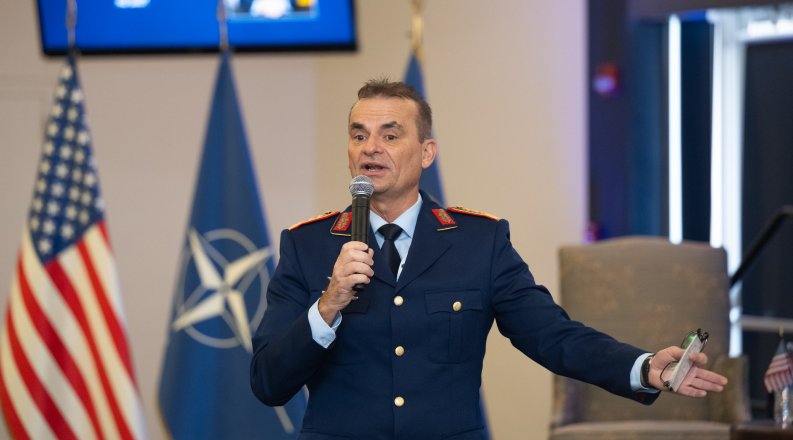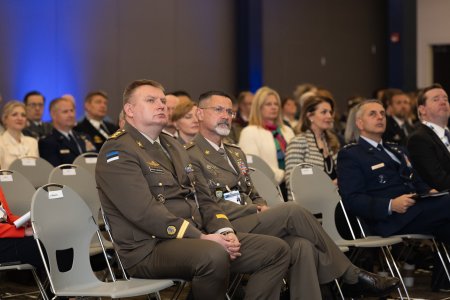Earlier this year, Old Dominion University hosted the NATO Academic Conference 2024, a key event leading up to the Washington Summit marking 75 years of the North Atlantic Treaty Organization.
Conference attendees explored the topic, “Alliances and Partnerships in a Complex and Challenging Security Environment.” In panel discussions and breakout sessions held March 11-13, experts exchanged views about threats, trends and opportunities.
Throughout, they considered the value of NATO in the current geopolitical climate.
“NATO remains the preeminent security Alliance that brings strategic advantage to its members and partners as a force multiplier with strategic flexibility and depth that can help shape and contest the strategic environment,” reads the executive summary of a conference compendium published this month. “However, new alliances are emerging and in a multi-polar world, with increasing mini-lateralism — NATO must adapt.”
The 226-page compendium includes 18 essays including those with titles “NATO’s Gray Zone Challenge: Implications of the Russia-China Partnership” and “The End is NOT Nigh: Rethinking the Notion of Alliances.”
Old Dominion University professors Regina Karp and Richard Maass edited the document and wrote its introductory essay, “NATO at 75 Years.”
Below, Karp and Maass answer questions about the conference and the significance of NATO’s Washington Summit which took place July 9-10.
Q: Did Old Dominion students get to attend the academic conference? If so, what was their reaction?
A: Not only did students get to attend the conference, NATO itself is keen to reach out to a new generation of leaders. Among the many students who attended, four graduate students from the Graduate Program in International Studies served as rapporteurs in breakout sessions and briefed the entire conference on how students view the future of NATO. Their essays were included in the conference compendium. It was a unique opportunity for students to engage with leading international security experts. — RK
Q: In the view of conference presenters, how would better ties between NATO and the European Union benefit the world right now?
A: There was general agreement that the relationship between NATO and the EU can and should be developed further. Together, they represent our Western way of life, our values and interests in many different domains. Organizationally, of course, they are different, with NATO led by the United States and the EU without a lead country. What conference participants did recommend is that the focus of cooperation should be a release of synergies that would strengthen both organizations and provide a bulwark against aggressive, non-democratic challenges. — RK
Q: Is there a misconception that western security leaders wanted to dispel about the evolving partnership between Russia and China?
A: No, there is no misconception. The purpose of Russian-Chinese alignment is to create a counterweight to the US-led liberal international order. Conference participants recognized that although Russia and China have little in common otherwise, their joint opposition to what the West stands for makes their alliance a formidable threat. — RK
Q: Why are the economic and social challenges facing African nations relevant to NATO, according to conference participants?
A: To be an effective alliance, NATO needs partners around the world, especially in Africa where Russia and China are already actively promoting their vision of a non-western future. The West must get better at engaging the many issues that impede economic and social development in African countries. Conference participants recognized that NATO’s and the EU’s greatest challenge is to overcome colonial legacies on the African continent and help promote African solutions, not lecture leaders on what’s best for their countries. — RK
Q: The war in Ukraine has brought NATO’s value back into focus for some nations. Is there a moment in the history of the alliance that resembles this one? Are there lessons we can take away from how earlier events unfolded?
A: The short answer is no. Prior to Russia’s annexation of Crimea in 2014 and the full-fledged invasion of Ukraine in 2022, there had not been war on the European continent since 1945. NATO had its share of crises throughout its history, but nothing compares to the collapse of the European security order that Russia provoked. The situation is unprecedented, and we need to be united in countering blatant aggression and threats to our way of life. — RK
Q: What are some key differences in the NATO we see today and the one that emerged 75 years ago?
A: NATO today is an unparalleled defensive alliance among 32 countries spanning the European continent and North America, many of which rank among the world’s wealthiest countries with its most powerful militaries. That is quite different from 75 years ago, when 12 countries ringing the North Atlantic coastlines created NATO in the face of a massive Soviet military that occupied much of Eastern Europe. — RM
Q: The essay “NATO at 75 Years” suggests that “the risks and costs of democratic backsliding within NATO member states are more urgent today than at any point since the late 1940s.” What current conditions are creating a climate where backsliding is more likely?
A: Unfortunately, democratic norms like the rule of law, representative governance, minority rights, judiciary independence, and institutional constraints on executive power have been eroded and remain under threat in a number of NATO member states. NATO’s Atlantic Charter identifies such norms as key values of the alliance, but their defense begins at home. — RM
Q: Did conference participants describe specific dangers in NATO expanding into a global alliance?
A: NATO must inevitably weigh the proper balance of resources and attention to threats within the trans-Atlantic region vs. those emanating from abroad. Conference participants considered many such dangers, including specifically those emerging from the partnership between China and Russia as well as from Sub-Saharan Africa. — RM
Q: What essay in the compendium did you find most surprising and why?
A: Readers may be surprised by the contrast between NATO’s impressive record of success and unparalleled capabilities on one hand versus the diverse threats and challenges it continues to face on the other hand. Several of the essays in the compendium highlight this contrast, which is central to accurately understanding the alliance’s position today. — RM
Q: Did either of you attend the Washington Summit? Regardless, was there a part of it that you found most interesting or significant?
A: We were unable to attend the Washington Summit due to prior travel obligations, but we monitored developments there closely. Two particularly significant aspects were (1) the widespread recognition that domestic politics within NATO members is as fundamental to alliance cohesion as ever, and (2) the involvement of partners like Ukraine and Indo-Pacific nations. Both will fundamentally shape the alliance moving forward. — RM
Top Image: Supreme Allied Commander Transformation General Chris Badia addresses the NATO Academic Conference 2024 at Old Dominion University. Photo by Nicholas Clark/ODU




